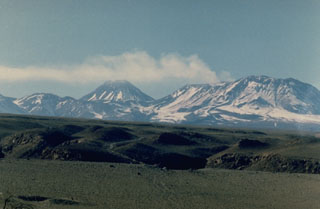Report on Lascar (Chile) — June 2015
Bulletin of the Global Volcanism Network, vol. 40, no. 6 (June 2015)
Managing Editor: Edward Venzke.
Lascar (Chile) Intermittent incandescence seen in October and November 2013
Please cite this report as:
Global Volcanism Program, 2015. Report on Lascar (Chile) (Venzke, E., ed.). Bulletin of the Global Volcanism Network, 40:6. Smithsonian Institution. https://doi.org/10.5479/si.GVP.BGVN201506-355100
Lascar
Chile
23.37°S, 67.73°W; summit elev. 5592 m
All times are local (unless otherwise noted)
An eruption at Láscar during 2 April-17 July 2013 included summit incandescence and some gray plumes (BGVN 38:07). Though no additional plumes were reported, incandescence was again observed during the first half of October and on 20 November 2013. The Observatorio Volcanológico de los Andes del Sur (OVDAS) in Temuco, part of the Servicio Nacional de Geología y Minería (SERNAGEOMIN) monitors the volcano and issues reports following periods of volcanism. Monitoring methods include several webcams, GPS, airborne and remote sensing surveillance (e.g., Landsat), and data gathered by OMI (Ozone Monitoring Instrument) on the NASA Aura satellite.
Following the minor eruptive activity during April-July 2013, seismicity returned to lower levels. The Alert Level remained at Green (the lowest of 4 levels) for the remainder of the year. Between 1 and 30 October, four volcano-tectonic (VT) seismic events occurred, with a magnitude of 1 localized in the immediate area of the crater at a depth of less than 2 km. On 1, 6, and 11-13 October incandescence was observed at the main crater.
During 1-30 November 2013 there were 10 seismic events recorded, nine of which were VT events. The largest event was located 15 km NE of the crater, at a depth of 9.5 km, and with a magnitude of 1.5. The final seismicity was a long-period (LP) event, related to the movement of fluids within the interior of the volcano and with a magnitude of 0.5. On 20 November incandescence was again observed at the crater.
Geological Summary. Láscar is the most active volcano of the northern Chilean Andes. The andesitic-to-dacitic stratovolcano contains six overlapping summit craters. Prominent lava flows descend its NW flanks. An older, higher stratovolcano 5 km E, Volcán Aguas Calientes, displays a well-developed summit crater and a probable Holocene lava flow near its summit (de Silva and Francis, 1991). Láscar consists of two major edifices; activity began at the eastern volcano and then shifted to the western cone. The largest eruption took place about 26,500 years ago, and following the eruption of the Tumbres scoria flow about 9000 years ago, activity shifted back to the eastern edifice, where three overlapping craters were formed. Frequent small-to-moderate explosive eruptions have been recorded since the mid-19th century, along with periodic larger eruptions that produced ashfall hundreds of kilometers away. The largest historical eruption took place in 1993, producing pyroclastic flows to 8.5 km NW of the summit and ashfall in Buenos Aires.
Information Contacts: Observatorio Volcanológico de los Andes del Sur (OVDAS), Temuco, Chile (URL: http://www.sernageomin.cl/volcan-observatorio.php); Servicio Nacional de Geología y Minería (SERNAGEOMIN), Avda Sta María No. 0104, Santiago, Chile (URL: http://www.sernageomin.cl/)); Oficina Nacional de Emergencia Ministerio del Interior (ONEMI) (URL: http://www.onemi.cl/).

